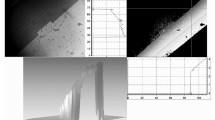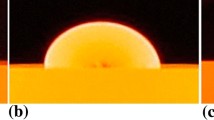The sessile drop method using capillary melt cleaning was employed in the experiment to study the effect of metallic nanocoatings (single Ti, Nb, and Mo coatings and binary Ti–Cu, Nb–Cu, and Mo–Cu coatings with a copper layer of constant thickness) on the wetting of silicon oxide by Pb–15 wt.% In melt in 1 ∙ 10–3 Pa vacuum at 500°C after their annealing at 900°C. The metallic coatings were applied by electron beam evaporation in vacuum. The binary coatings were produced by sequential deposition of layers. The dependences of contact angle on coating thickness show that the ‘threshold’ thickness is determined by the annealing temperature of the coating or, in other words, its structure. The threshold coating thickness for different metals depends on their chemical affinity to oxygen. When freshly applied and annealed single Mo, Nb, and Ti coatings are wetted, their threshold thickness increases from 70 to 80 nm for the titanium coating, from 63 to 70 nm for the niobium coating, and from 50 to 60 nm for the molybdenum coating. The structure of Cu, Ni, Mo, Cr, Nb, and Ti coatings annealed at 600, 900, and 1200°C was studied. The initial (freshly deposited) metallic coatings showed high integrity. The coatings became dispersed after annealing and their integrity decreased with increasing temperature. The dispersed metallic coatings formed ‘islands’ of various shapes, round shape being predominant, depending on the chemical affinity of the coating metal to oxygen. The so-called ‘solid’ wetting was observed. The shape of the islands is determined by equilibrium between the metal–substrate attraction forces (interaction, adhesion) and the very strong surface tension of the metal (at such a small coating thickness). To use metallic coatings for brazing quartz with aluminum alloys, coatings of adhesive metals (Mo, Cr, Nb, Ti) should be annealed at temperatures of 900–1000°C with a holding time of 10 min. The coating thickness should be within the threshold range.





Similar content being viewed by others
References
V.P. Krasovskyy, B.D. Kostyuk, I.I. Gab, N.A. Krasovskaya, and T.V. Stetsyuk, “Effect of metallic nanocoatings deposited on silicon oxide on wetting by filler melts. I. Wetting of Ti, Nb, Cr, V, and Mo nanocoatings deposited on SiO2 with filler melts,” Powder Metall. Met. Ceram., 59, No. 1–2, 29–34 (2020).
Yu.V. Naidich, Yu.N. Chuvashov, N.F. Ishchuk, and V.P. Krasovskyy, “Wetting of some nonmetallic materials by aluminum,” Powder Metall. Met. Ceram., 22, No. 6, 481–483 (1983).
Yu.V. Naidich, B.D. Kostyuk, G.A. Kolesnichenko, and S.S. Shaikevich, “Wettability in the metallic melt–thin metallic coating–nonmetallic substrate system,” in: Physical Chemistry of Condensed Phases, Superhard Materials, and Their Interfaces [in Russian], Naukova Dumka, Kyiv (1975), pp. 15–27.
Yu.V. Naidich, I.I. Gab, T.V. Stetsyuk, and B.D. Kostyuk, “Dispersion kinetics for chromium nanofilms deposited onto oxide materials in vacuum annealing,” Adhez. Raspl. Paika Mater., Issue 51, 54–61 (2018).
B.D. Kostyuk, Yu.V. Naidich, G.A. Kolesnichenko, and S.S. Shaikevich, “Studying the wetting of binary Mo–Cu, Ti–Cu, and V–Cu films deposited on SiO2 by tin melt,” Adhez. Raspl. Paika Mater., Issue 12, 11– 13 (1982).
G.A. Kolesnichenko, B.D. Kostyuk, and A.N. Roshchin, “Interaction of thin Cu, Ge, V, and V–Cu films with quartz and their structure in high-temperature annealing,” Adhez. Raspl. Paika Mater., Issue 14, 55–61 (1985).
Yu.V. Naidich, I.I. Gab, B.D. Kostyuk, and T.V. Stetsyuk, “Study of the joining (brazing) of ceramic materials with use of metal nanofilms,” Dop. Nats. Akad. Nauk NAN Ukrainy, No. 5, 97–104 (2007).
Yu.V. Naidich, “The wettability of solids by liquid metals,” Prog. Surf. Membr. Sci., 14, 353–484 (1981).
Yu.V. Naidich, I.I. Gab, T.V. Stetsyuk, and B.D. Kostyuk, “Dispersion kinetics in vacuum annealing of molybdenum nanocoatings deposited on oxide materials,” Metallofiz. Noveish. Tekhnol., 40, No. 10, 1359– 1373 (2018).
Yu.V. Naidich, I.I. Gab, T.V. Stetsyuk, and B.D. Kostyuk, “Dispersion kinetics in vacuum annealing of chromium and nickel nanocoatings deposited on oxide materials,” Fiz. Khim. Tverd. Tela, No. 3, 516–522 (2014).
M. Hansen and K. Anderko, Constitution of Binary Alloys, McGraw-Hill, New York (1958).
F. Shank, Constitution of Binary Alloys, McGraw-Hill, New York (1970).
Author information
Authors and Affiliations
Corresponding author
Additional information
Translated from Poroshkova Metallurgiya, Vol. 59, Nos. 3–4 (532), pp. 20–29, 2020.
Rights and permissions
About this article
Cite this article
Krasovskyy, V., Kostyuk, B., Gab, I. et al. Effect of Metallic Nanocoatings Deposited on Silicon Oxide on Wetting by Filler Melts II. Effect from the Annealing of Nanocoatings Deposited on SiO2 on their Structure and Interaction with the Oxide. Powder Metall Met Ceram 59, 134–140 (2020). https://doi.org/10.1007/s11106-020-00146-5
Received:
Published:
Issue Date:
DOI: https://doi.org/10.1007/s11106-020-00146-5




